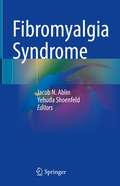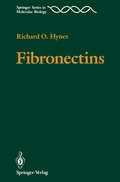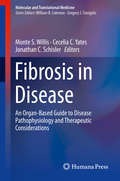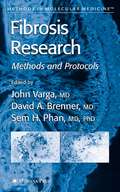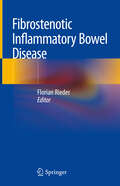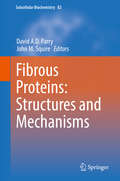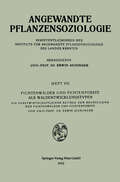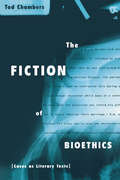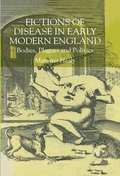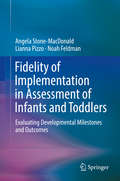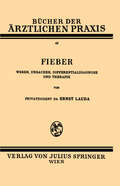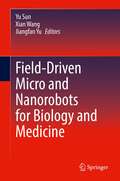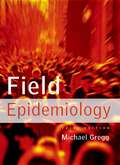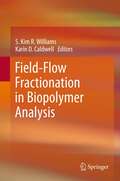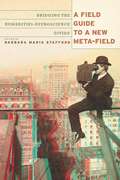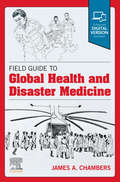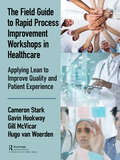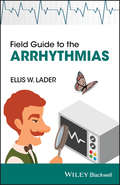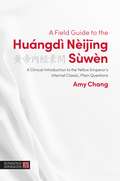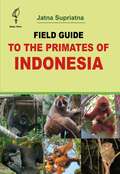- Table View
- List View
Fibromyalgia Syndrome
by Yehuda Shoenfeld Jacob N. AblinThis book provides a comprehensive overview of fibromyalgia syndrome that focuses on integrating concepts relevant to the pathogenesis, epidemiology and treatment of the condition. Details of how to manage sleep disorders, assess related disabilities, use pharmacological and complementary treatments are provided. Relevant aspects of neuromodulation, genetics, and neuromodulation are also covered. Therefore, enabling the reader to develop a deep understanding of the underlying triggers of and tools for assessing and treating fibromyalgia. Fibromyalgia Syndrome features a wealth of information on the basic science and contains guidance on how to make clinical decisions when treating patients with this condition, and is a valuable resource for any medical professional or trainee seeking a dedicated up-to-date resource on the topic.
Fibronectins (Springer Series in Molecular and Cell Biology)
by Richard O. HynesFibronectins comprise a class of high molecular weight glycoproteins present both in extracellular matrices and in soluble form in body fluids. Although they have been studied for about forty years, their real significance emerged only during the past decade. Intensive research has focused on their role in platelet function, cell migration, the cytoskeleton, reticuloendothelial function, and on alterations in fibronectin distribution during development and disease. Fibronectins have emerged as glycoproteins with a very interesting set of properties generally involving adhesion of cells to cells or to extracellular material. In more recent years, the complete sequences of several fibronectin molecules and their genes were determined, the relation between structure and function was understood and much has been learned about cell surface receptors for fibronectins and other adhesive ligands. Having been at the forefront of all these exciting developments, the author has synthesized the entire field and with all the latest information at hand for the first time given it a clear perspective.
Fibrosis in Disease: An Organ-based Guide To Disease Pathophysiology And Therapeutic Considerations (Molecular and Translational Medicine)
by Monte S. Willis Cecelia C. Yates Jonathan C. SchislerFibroproliferative diseases are a broad spectrum of entities from organ-specific involvement (e.g., pulmonary, heart, liver, and kidney fibrosis) to multi-system diseases such as systemic sclerosis and sclerodermatous graft vs. host disease. These diseases also encompass pathophysiologies not readily recognizably related, such as macular degeneration and cancer metastasis. Fibroproliferative diseases are a leading cause of morbidity and mortality and can affect all tissues and organ systems. Remarkable progress in elucidating the pathogenesis of these common diseases with fibrotic components, including the critical roles of myofibroblasts and the molecular mechanisms driving the transcriptional activation involved in the induction of fibrosis. As the importance of these processes is realized in the long-term recovery and treatment of diseases, effective anti-fibrotic therapies targeting the underlying ongoing disease processes are lacking. The complexity of discovering and applying therapies to fibroproliferative disease may be due to the diversity of the systems the pathogenesis of disease itself involves. By nature, fibroproliferative diseases are interdisciplinary, involving multiple cell types (organ-specific epithelial cells), immune cells, endothelial cells, and fibroblasts. Bone marrow, cytokines, and organ-specific pathologies further speckle both the clinical and scientific disciplines in such a way that communication is often limited to the clinical or scientific tribes we live in, despite the greatest access to information known to man available today. Therefore, the primary focus of this text is to bring together authors from a diversity of both clinical, scientific, and therapeutic backgrounds for readers to more fully appreciate that fantastic platform that is available to build upon to lessen the isolation of the clinical and scientific disciplines. With advances in the discovery of pre-clinical therapeutic targets (at least 20+ to date) involving TGF-beta (and other cytokines), transcription factors, and downstream kinases, it’s important to both recognize the broader impact and potential opportunities that exist even today. This book will serve as a state-of-the-art resource for physicians and translational medical researchers alike who are interested in the rapidly evolving field of fibroproliferative diseases. The book will provide new insight into the fundamental mechanisms of classic fibrotic pathophysiologic processes like myocardial infarction, idiopathic pulmonary fibrosis, chronic kidney disease, wound healing, and systemic sclerosis. It will also highlight the many new areas of therapeutic investigation currently underway. Lastly, we will touch upon newly emerging fields investigating the role of fibrosis in macular degeneration and cancer metastasis. The chapters will be written by established experts in their fields, including clinicians (cardiologists, cardiovascular surgeons, pathologists, and general practitioners) and translational biomedical researchers in a wide range of disciplines. However, the material will certainly have a broader audience including medical residents, fellows, and general practitioners as well as M.D. or Ph.D. post-doctoral research fellows. While comprehensive, we'll attempt to present the material in a manner that simplifies the complex pathophysiologic mechanisms that underlie common fibroproliferative diseases while making it appealing to a broad audience.
Fibrosis Research: Methods and Protocols (Methods in Molecular Medicine #117)
by John Varga, David A. Brenner and Sem H. PhanLeading investigators review the highlights of current fibrosis research and the experimental methodologies used uncover the mechanisms that drive it. In their discussion of research methodologies utilizing cultured cells to model various aspects of the fibrotic response in vitro, the authors describe the isolation, characterization, and propagation of mesenchymal cells, and highlight the similarities and differences between methods that are appropriate for different types of fibroblasts. Approaches for studying collagen gene regulation and TGF-b production are also discussed, along with experimental methodologies utilizing animal models to study the pathogenesis of fibrosis. The protocols follow the successful Methods in Molecular Medicine™ series format, each offering step-by-step laboratory instructions, an introduction outlining the principles behind the technique, lists of the necessary equipment and reagents, and tips on troubleshooting and avoiding known pitfalls.
Fibrostenotic Inflammatory Bowel Disease
by Florian RiederThis book provides a comprehensive account of the pathogenesis and treatment of intestinal fibrosis, covering both the clinical and molecular aspects of the disease. It begins by describing the epidemiology and genetics of fibrostenosing IBD in Crohn’s disease and Ulcerative colitis as well as the epigenetics and cellular and molecular mechanisms of the disease. Readers will obtain an in-depth overview of the disease from biomarkers and histology to surgical intervention, imaging and current and future drug therapies. Medical management of fibrosis, endoscopy and imaging as well as surgical approaches are all discussed. Through the links to videos contained in the book, the reader will become familiar with interventional procedures such as endoscopic balloon dilation and surgical techniques for stricturing IBD, such as resection and strictureplasties. This is an indispensable volume for anyone working on fibrostenotic IBD, such as gastroenterologists, internists, radiologists, colorectal surgeons, pathologists and researchers. It has been written by a team of top experts from North America, Asia and Europe.
Fibrous Proteins: Structures and Mechanisms (Subcellular Biochemistry #82)
by David A.D. Parry John M. SquireThis book provides the readers with an up-to-date review of the design, structure and function of a representative selection of fibrous proteins in both health and disease. The importance of the α-helical coiled coil, a conformational motif based on the heptad repeat in the amino acid sequence of all α-fibrous proteins (and parts of some globular proteins) is underlined by three Chapters devoted to its design, structure, function and topology. Specific proteins covered in the text and which depend on the coiled coil for their structure and function, include the intermediate filament proteins, tropomyosin, myosin, paramyosin, fibrin and members of the spectrin superfamily. Also described are fibrous proteins based on the β-pleated sheet and collagen conformations. Recombinant structural proteins, especially of silk and collagen, are discussed in the context of developing new biomaterials with varied applications. Established researchers and postgraduate students in the fields of protein chemistry, biochemistry and structural biophysics will find Fibrous Proteins: Structures and Mechanisms to be an invaluable collection of topical reviews that describe the basic advances made in the field of fibrous proteins over the past decade. This book, written by recognized authorities in the field, provides a clear account of the current status of fibrous protein research and, in addition, establishes the basis for deciding the most appropriate directions for future activity, including the applications of protein engineering and the commercial exploitation of new biomaterials.
Fichtenwälder und Fichtenforste als Waldentwicklungstypen: Ein Forstwirtschaftlicher Beitrag zur Beurteilung der Fichtenwälder und Fichtenforste (Angewandte Pflanzensoziologie #7)
by Erwin AichingerThe Fiction of Bioethics (Reflective Bioethics)
by Tod ChambersTod Chambers suggests that literary theory is a crucial component in the complete understanding of bioethics. The Fiction of Bioethics explores the medical case study and distills the idea that bioethicists study real-life cases, while philosophers contemplate fictional accounts.
The Fiction of Bioethics (Reflective Bioethics)
by Tod ChambersTod Chambers suggests that literary theory is a crucial component in the complete understanding of bioethics. The Fiction of Bioethics explores the medical case study and distills the idea that bioethicists study real-life cases, while philosophers contemplate fictional accounts.
Fictions of Disease in Early Modern England: Bodies, Plagues and Politics
by M. HealyHow did early modern people imagine their bodies? What impact did the new disease syphilis and recurrent outbreaks of plague have on these mental landscapes? Why was the glutted belly such a potent symbol of pathology? Ranging from the Reformation through the English Civil War, Fictions of Disease in Early Modern England is a unique study of a fascinating cultural imaginary of 'disease' and its political consequences. Healy's original approach illuminates the period's disease-impregnated literature, including works by Shakespeare, Milton, Dekker, Heywood and others.
Fidelity: 'The book about infidelity that has shaken up Italy - and is coming to Netflix' (The Times)
by Marco MissiroliSOON TO BE A NETFLIX LIMITED SERIES 'An absolute scorcher' Evening Standard'Fidelity thrilled me, made me think and moved me deeply. It manages to be as deep as any literature and as irresistible as any gossip. A brilliant work by a brilliant writer' Jonathan Safran Foer'A gripping novel exploring the tensions in an apparently idyllic marriage, where a couple in their thirties is tested by their attraction to others, and by their own accumulation of desires and disappointments' Financial Times 'Cuts right through to the darkness of our inner lives' Roberto Saviano'Set to get Britons feeling hot under the collar'Daily MailCarlo, a part-time professor of creative writing, and Margherita, an architect-turned-real estate-agent: a happily married couple in their mid-thirties, perfectly attuned to each other's restlessness. They are in love, but they also harbour desires that stray beyond the confines of their bedroom: Carlo longs for the quiet beauty of one of his students, Sofia; Margherita fantasises about the strong hands of her physiotherapist, Andrea.But it is love, with its unassuming power, which ultimately pulls them from the brink, aided by Margherita's mother Anna, the couple's anchor and lighthouse - a wise, proud seamstress hiding her own disappointments.But after eight years of repressed desires and the birth of a son, when the past resurfaces in the form of books sent anonymously, will love be enough to save them? A no. 1 international bestsellerSoon to be a Netflix show directed by Andrea Molaioli, director of the Netflix hit series SuburraWinner of the Premio Strega GiovaniShortlisted for the Premio Strega'Powerful, delicate, exquisite' Claudio Magris 'Masterful... The ending is just as good as that of Joyce's The Dead' Corriere della Sera'You'll feel like taking refuge in this book and never leaving its confines' La Stampa'With all-encompassing writing, Marco Missiroli opens the rooms of his characters and the streets of Milan, the thoughts and the concealed desires, makes dialogue and silences reverberate with the spontaneity of great narrators' Il Foglio
Fidelity of Implementation in Assessment of Infants and Toddlers: Evaluating Developmental Milestones and Outcomes
by Angela Stone-MacDonald Lianna Pizzo Noah FeldmanThis book examines the challenges in developmental assessment of infants and toddlers and provides best practices for implementing standardized assessments in early intervention settings. It starts with an overview of standardized assessment practices and discusses how specific tools can be used in early intervention for different purposes (e.g., eligibility for services). The book explains the importance of the Fidelity of Implementation of Assessment (FOI-A) approach in creating standardized assessment for infants and toddlers. Chapters provide a checklist-based framework for FOI-A, with details on technological supports for test administration and data collection as well as training and supervision models. In addition, chapters discuss ways of engaging families, gaining their trust, and including them in their children’s educational planning.Topics featured in this book include:The Battelle Development Inventory, 2nd Edition (BDI-2) and its use in the assessment of young children. Using checklists to improve fidelity of implementation for standardized assessments.Using checklists to support early intervention directors and teams.How to provide feedback to early interventionists and other professionals on FOI-A.Recommendations to improve FOI-A.Fidelity of Implementation in Assessment of Infants and Toddlers is a must-have resource for researchers, clinicians and related professionals, and graduate students in varied fields including child and school psychology, pediatrics, social work, behavioral therapy, infant and early childhood development, and early education and care.
Fieber: Wesen, Ursachen, Differentialdiagnose und Therapie
by Ernst LaudaDieser Buchtitel ist Teil des Digitalisierungsprojekts Springer Book Archives mit Publikationen, die seit den Anfängen des Verlags von 1842 erschienen sind. Der Verlag stellt mit diesem Archiv Quellen für die historische wie auch die disziplingeschichtliche Forschung zur Verfügung, die jeweils im historischen Kontext betrachtet werden müssen. Dieser Titel erschien in der Zeit vor 1945 und wird daher in seiner zeittypischen politisch-ideologischen Ausrichtung vom Verlag nicht beworben.
Field-Driven Micro and Nanorobots for Biology and Medicine
by Yu Sun Xian Wang Jiangfan YuThis book describes the substantial progress recently made in the development of micro and nanorobotic systems, utilizing magnetic, optical, acoustic, electrical, and other actuation fields. It covers several areas of micro and nanorobotics including robotics, materials science, and biomedical engineering. Field-Driven Micro and Nanorobots for Biology and Medicine provides readers with fundamental physics at the micro and nano scales, state-of-the-art technical advances in field-driven micro and nanorobots, and applications in biological and biomedical disciplines.
Field Epidemiology
by Michael GreggThis book is the definitive guide to field epidemiology- the application of epidemiologic methods to unexpected health problems when a rapid, on-site investigation is necessary. As such, it is an indispensable resource for state and local health agencies and healthcare professionals. This third edition includes a chapter on environmental investigations and one on immunization strategies and evaluation. Chapters have been revised and updated with new cases and examples.
Field Epidemiology
by Michael B. GreggThis book is the definitive guide to field epidemiology- the application of epidemiologic methods to unexpected health problems when a rapid, on-site investigation is necessary. As such, it is an indispensable resource for state and local health agencies and healthcare professionals. This third edition includes a chapter on environmental investigations and one on immunization strategies and evaluation. Chapters have been revised and updated with new cases and examples.
Field-Flow Fractionation in Biopolymer Analysis
by S. Kim R. Williams and Karin D. CaldwellThis is a timely collection of important biomedical applications for a set of separation/characterization techniques that are rapidly gaining popularity due to their wide dynamic range, high resolution, and ability to function in most commonly used solvent systems. Importantly, the field-flow fractionation (FFF) technique has recently emerged as a prominent complement to size exclusion chromatography for protein pharmaceuticals. Fractionation with FFF is gentle and preserves protein structural integrity better than existing alternatives. In the present text, different chapters are written by experts in their respective field of application, who offer comparisons between the FFF techniques and other methods for characterizing their special focus material. Practical guide-lines for successful implementation, such as choice of operating conditions, are offered in conjunction with each application. In addition to new instrumentation and approaches that address important current topics, readers are provided with an overall sense of prior (but timeless) major developments that may be overlooked in literature searches.
A Field Guide to a New Meta-field: Bridging the Humanities-Neurosciences Divide
by Barbara Maria StaffordBarbara Stafford is a pioneering art historian whose research has long helped to bridge the divide between the humanities and cognitive sciences. In A Field Guide to a New Meta-Field, she marshals a distinguished group of thinkers to forge a ground-breaking dialogue between the emerging brain sciences, the liberal arts, and social sciences. Stafford’s book examines meaning and mental function from this dual experimental perspective. The wide-ranging essays included here—from Frank Echenhofer’s foray into shamanist hallucinogenic visions to David Bashwiner’s analysis of emotion and danceability—develop a common language for implementing programmatic and institutional change. Demonstrating how formerly divided fields are converging around shared issues, A Field Guide to a New Meta-Field maps a high-level, crossdisciplinary adventure from one of our leading figures in visual studies.
Field Guide to Global Health & Disaster Medicine - E-Book
by James A. ChambersWhile serving as a physician overseas in resource-poor countries, Dr. James Chambers recognized the need for a practical, portable reference for non-specialist healthcare providers to orient them to common issues when serving in new situations, whether due to geography, austere environments, or complex humanitarian disasters. Field Guide to Global Health and Disaster Medicine draws on the experience, training, and perspectives of committed healthcare providers from diverse nations and backgrounds to provide the most essential information for maximum utility in the field—whether in a refugee camp, operating room, disaster response scene, or other demanding environment. Helps providers prepare for service overseas, organize data to develop differential diagnoses, assimilate information on infectious and environmental diseases, and effectively serve the patients they will encounter. Provides concise, easy-to-read coverage of how to approach a differential diagnosis for infectious diseases overseas; nutritional, sexual, and environmental conditions; surgical and anesthesia care; long-term and short-term systems-based challenges, and more. Covers key topics such as Approach to Refugees and Internally Displaced Persons, Medical Response to Disasters, Mental Health in War and Crisis Regions, and Considerations for Pandemic Preparedness and Response. Acknowledges the wide variance of different cultures, motives, resources, and limitations in the global health arena, and helps readers understand the factors which impact the efficacy and sustainability of care strategies.
The Field Guide to Rapid Process Improvement Workshops in Healthcare: Applying Lean to Improve Quality and Patient Experience
by Cameron Stark Gavin Hookway Gill McVicar Hugo Van WoerdenThis book takes the reader through the process to plan, deliver, and follow-up a weeklong Lean Quality Improvement event, usually termed a ‘Rapid Improvement Event’ or ‘Rapid Process Improvement Workshop (RPIW).’ Drawing on the experience of conducting over 100 of these workshops, the book gives readers the information to plan and run their own event. It describes how RPIWs fit in to wider improvement processes and how the reader can maximize these processes in their own organization. These weeklong improvement events are popular in health and social care, but there are no textbooks available to support them. There are several books that describe the use of shorter Kaizen events in health care, but none that describe the process of delivering weeklong events. The events have a rhythm specific to the one-week format, and the book seeks to help people to make use of best practice and to avoid common problems. Based on the experiences of the authors, this book includes an introduction to Lean concepts linked to the relevant part of the process description; examples and templates of forms that can be used in workshops; and photographs of actual events.
The Field Guide to Rapid Process Improvement Workshops in Healthcare: Applying Lean to Improve Quality and Patient Experience
by Cameron Stark Gavin Hookway Gill McVicar Hugo Van WoerdenThis book takes the reader through the process to plan, deliver, and follow-up a weeklong Lean Quality Improvement event, usually termed a ‘Rapid Improvement Event’ or ‘Rapid Process Improvement Workshop (RPIW).’ Drawing on the experience of conducting over 100 of these workshops, the book gives readers the information to plan and run their own event. It describes how RPIWs fit in to wider improvement processes and how the reader can maximize these processes in their own organization. These weeklong improvement events are popular in health and social care, but there are no textbooks available to support them. There are several books that describe the use of shorter Kaizen events in health care, but none that describe the process of delivering weeklong events. The events have a rhythm specific to the one-week format, and the book seeks to help people to make use of best practice and to avoid common problems. Based on the experiences of the authors, this book includes an introduction to Lean concepts linked to the relevant part of the process description; examples and templates of forms that can be used in workshops; and photographs of actual events.
Field Guide to the Arrhythmias
by Ellis Lader…The cardiac unit is a jungle, inhabited by fierce nurses, killer intensivists, marauding attendings, various flesh-eating specialists, sick patients, and lots of arrhythmias. –from the Preface Can you recognize the call of the normal sinus rhythm? Name the natural habitat of Multifocal Atrial Tachycardia or Ventricular Fibrillation? Are you well-versed in the proper care and feeding of Asystole and Atrial Flutter? If you answered “no” to any of these questions, then you need this trusty guide to help you identify and respond to arrhythmias in the veritable wilderness of the busy hospital ward. Created by a seasoned physician educator at a major urban medical center and inspired by the “field guides” used by birders, botanists and the like to identify flora or fauna in the wild, this new book offers a unique – and uniquely humorous -- approach to mastering the ever-vexing challenge of arrhythmia identification. Each arrhythmia is covered beginning with a sample ECG strip, followed by brief text describing its significant characteristics; where and when it is likely to be encountered (its “Habitat”); comments, questions and queries likely to be heard from physicians and other colleagues on the ward (the “Call”); and finally what steps the reader needs to take upon identifying the arrhythmia in a patient (“Care and Feeding”). Dr. Lader’s approach brings the sights and sounds of a modern hospital to life, enabling you to understand arrhythmia diagnosis and clinical response in context, and his offbeat, sometimes irreverent humor makes each detail memorable. Fifty self-assessment questions are included to help you master arrhythmia essentials and test your knowledge.
Field Guide to the Arrhythmias
by Ellis Lader…The cardiac unit is a jungle, inhabited by fierce nurses, killer intensivists, marauding attendings, various flesh-eating specialists, sick patients, and lots of arrhythmias. –from the Preface Can you recognize the call of the normal sinus rhythm? Name the natural habitat of Multifocal Atrial Tachycardia or Ventricular Fibrillation? Are you well-versed in the proper care and feeding of Asystole and Atrial Flutter? If you answered “no” to any of these questions, then you need this trusty guide to help you identify and respond to arrhythmias in the veritable wilderness of the busy hospital ward. Created by a seasoned physician educator at a major urban medical center and inspired by the “field guides” used by birders, botanists and the like to identify flora or fauna in the wild, this new book offers a unique – and uniquely humorous -- approach to mastering the ever-vexing challenge of arrhythmia identification. Each arrhythmia is covered beginning with a sample ECG strip, followed by brief text describing its significant characteristics; where and when it is likely to be encountered (its “Habitat”); comments, questions and queries likely to be heard from physicians and other colleagues on the ward (the “Call”); and finally what steps the reader needs to take upon identifying the arrhythmia in a patient (“Care and Feeding”). Dr. Lader’s approach brings the sights and sounds of a modern hospital to life, enabling you to understand arrhythmia diagnosis and clinical response in context, and his offbeat, sometimes irreverent humor makes each detail memorable. Fifty self-assessment questions are included to help you master arrhythmia essentials and test your knowledge.
A Field Guide to the Huángdì Nèijing Sùwèn: A Clinical Introduction to the Yellow Emperor's Internal Classic, Plain Questions (The Classics of Chinese Medicine in Clinical Practice)
by Amy ChangThe most important classical text of Chinese Medicine, The Yellow Emperor's Classic of Chinese Medicine is often seen as daunting by students who are faced with a variety of different translations, of which some may not be reliable. This introductory guide makes it accessible to all, providing a summary of each chapter which emphasises the clinical relevance of the text.The author draws out how the text can be used to inform and improve clinical practice. It avoids overly scholarly discussions, and does not dwell on the minutiae of translation, making this book an easy and enlightening read.
Field Guide to the Primates of Indonesia
by Jatna SupriatnaThis primate field guide can be used to refer to information on each species, or it can be used to find which species exist on each island, as shown at the back of the book. A list of primates in Indonesia is provided with local, English, and scientific names. Once the name is identified the user can go to the description of the genus and species. Also given is the conservation status of each species except for the most recently described, whose status is not yet known. The information on each species' natural history, behavior, ecology, and where to see it in parks and/or forested areas outside parks is included. Field Guide to the Primates of Indonesia primate drawings are by Stephen Nash and photographs were donated by many of the author's friends from Indonesia and abroad.
